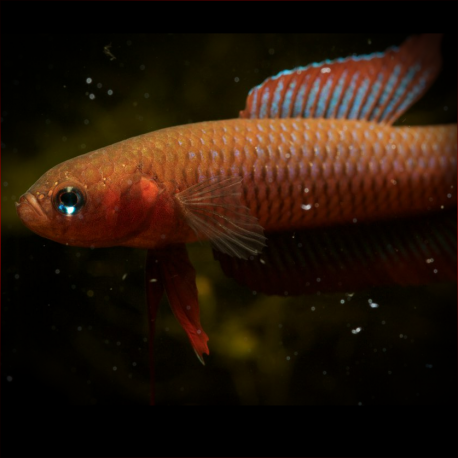More info
Datasheet
| Minimum Tank Size | 40 litres / 10.57 US gallons |
| Maximum Size | 3.6cm / 1.42inches |
| Temperature | 22°C / 71.60°F - 27°C / 80.60°F |
| Hardness | 1.01dgH / 18ppm - 5.04dgH / 90ppm |
| pH | 4.0-6.0 |
General Description
Betta Uberis, also previously known as Betta sp. ‘Sukadana’ or B. sp. ‘Pangkalanbun’, belongs to the B. coccina group within the Betta genus. These small, red-colored labyrinth fish are commonly found in peat swamp forests and associated streams. They possess an accessory breathing organ called the labyrinth, allowing them to breathe atmospheric air to some extent.
Aquarium Setup
When setting up an aquarium for Betta Uberis, a fully-decorated tank without substrate is preferred. Providing driftwood, branches, clay plant pots, and leaf litter for cover is essential. Dim lighting and aquatic plants like Microsorum, Taxiphyllum, or Cryptocoryne spp. are suitable. Maintaining acidic conditions with soft water and gentle filtration is vital.
Behaviour
Betts Uberis is not recommended for a standard community aquarium due to its territorial disposition. It is best kept alone or with very peaceful species. Reports vary on maintaining them in pairs or harem-type groups, with some suggesting rare physical aggression towards conspecifics. They may chase and squabble over territory, but actual damage is uncommon.
Feeding and Diet
In the wild, Betta Uberis likely preys on small aquatic and terrestrial invertebrates. Captive individuals accept dried products but should be offered live or frozen foods like Daphnia, Artemia, or bloodworms regularly. Overfeeding should be avoided as they are prone to obesity.
Reproduction & Dimorphism
As bubble nesters, Betta Uberis requires cover for the female during spawning. Males are more colorful and have extended fins compared to females. Spawning occurs beneath a nest, with males caring for eggs and fry. The male guards and tends the nest post-spawning, and fry can feed on microworms and Artemia nauplii.
Habitat and Distribution
Naturally, *Betta Uberis inhabits peat swamp forests and streams with darkly stained, acidic water. Originating from areas between the lower Arut and Kumai rivers in Kalimantan Tengah province, Borneo, Indonesia; they can also be found in the Sampit river basin and Sukadana district in Kalimantan Barat province.

